20 Files & File Systems
20 文件系统
Hi, I'm Carrie Anne, and welcome to Crash Course Computer Science!
嗨,我是 Carrie Anne,欢迎收看计算机科学速成课!
Last episode we talked about data storage, how technologies like magnetic tape and hard
上集我们讲了数据存储,磁带和硬盘这样的技术
disks can store trillions of bits of data,
可以在断电状态
for long durations, even without power.
长时间存上万亿个位
Which is perfect for recording "big blobs" of related data,
非常合适存一整块有关系的数据,
what are more commonly called computer files.
或者说"文件"
You've no doubt encountered many types,
你肯定见过很多种文件,
like text files, music files, photos and videos.
比如文本文件,音乐文件,照片和视频
Today, we're going to talk about how files work,
今天,我们要讨论文件到底是什么,
and how computers keep them all organized with File Systems.
以及计算机怎么管理文件
It's perfectly legal for a file to contain arbitrary, unformatted data,
随意排列文件数据完全没问题,
but it's most useful and practical if the data inside the file is organized somehow.
但按格式排会更好
This is called a file format.
这叫 "文件格式"
You can invent your own, and programmers do that from time to time,
你可以发明自己的文件格式,程序员偶尔会这样做
but it's usually best and easiest to use an existing standard, like JPEG and MP3.
但最好用现成标准,比如 JPEG 和 MP3
Let's look at some simple file formats.
来看一些简单文件格式,
The most straightforward are text files,
最简单的是文本文件
also know as TXT file, which contain...surprise! text.
也叫 TXT 文件, 里面包含的是.. 文字 (惊喜吧)
Like all computer files, this is just a huge list of numbers, stored as binary.
就像所有其它文件,文本文件只是一长串二进制数
If we look at the raw values of a text file in storage, it would look something like this:
原始值看起来会像这样:
We can view this as decimal numbers instead of binary,
可以转成十进制看,
but that still doesn't help us read the text.
但帮助不大
The key to interpreting this data is knowing that TXT files use ASCII,
解码数据的关键是 ASCII 编码
a character encoding standard we discussed way back in Episode 4.
一种字符编码标准,第 4 集讨论过.
So, in ASCII, our first value, 72, maps to the capital letter H.
第一个值 72,在 ASCII 中是大写字母 H
And in this way, we decode the whole file.
以此类推 解码其他数字
Let's look at a more complicated example: a WAVE File, also called a WAV,
来看一个更复杂的例子:波形(Wave)文件,也叫 WAV,
which stores audio.
它存音频数据
Before we can correctly read the data, we need to know some information,
在正确读取数据前,需要知道一些信息
like the bit rate and whether it's a single track or stereo.
比如码率(bit rate),以及是单声道还是立体声
Data about data, is called meta data.
关于数据的数据,叫"元数据"(meta data)
This metadata is stored at the front of the file, ahead of any actual data,
元数据存在文件开头,在实际数据前面,
in what's known as a Header.
因此也叫 文件头(Header)
Here's what the first 44 bytes of a WAV file looks like.
WAV 文件的前 44 个字节长这样
Some parts are always the same, like where it spells out W-A-V-E.
有的部分总是一样的,比如写着 WAVE 的部分
Other parts contain numbers that change depending on the data contained within.
其他部分的内容,会根据数据变化
The audio data comes right behind the metadata, and it's stored as a long list of numbers.
音频数据紧跟在元数据后面,是一长串数字
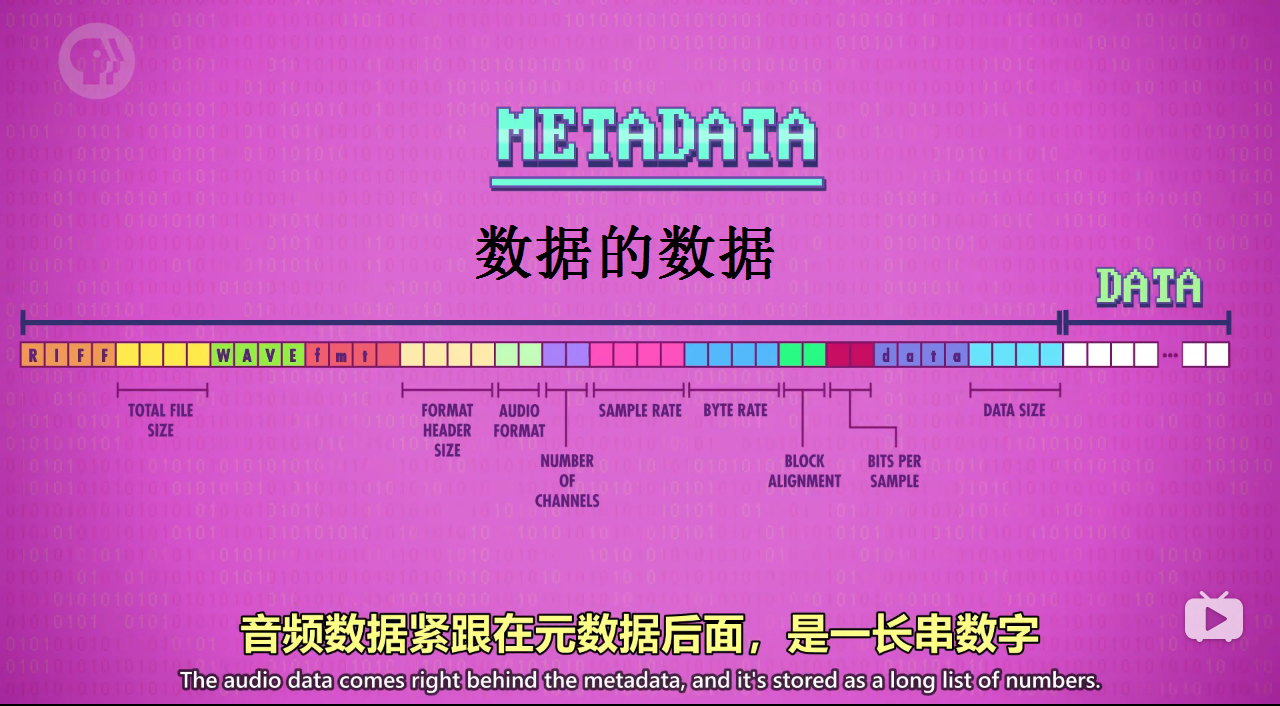
These values represent the amplitude of sound captured many times per second, and if you
数字代表每秒捕获多次的声音幅度
want a primer on sound, check out our video all about it in Crash Course Physics.
如果想学声音的基础知识,
Link in the dobblydoo.
可以看物理速成课
As an example, let's look at a waveform of me saying: "hello!" Hello!
举个例子,看一下"你好"的波形
Now that we've captured some sound, let's zoom into a little snippet.
现在捕获到了一些声音,我们放大看一下
A digital microphone, like the one in your computer or smartphone,
电脑和手机麦克风,
samples the sound pressure thousands of times.
每秒可以对声音进行上千次采样
Each sample can be represented as a number.
每次采样可以用一个数字表示
Larger numbers mean higher sound pressure, what's called amplitude.
声压越高数字越大,也叫"振幅"
And these numbers are exactly what gets stored in a WAVE file!
WAVE 文件里存的就是这些数据!
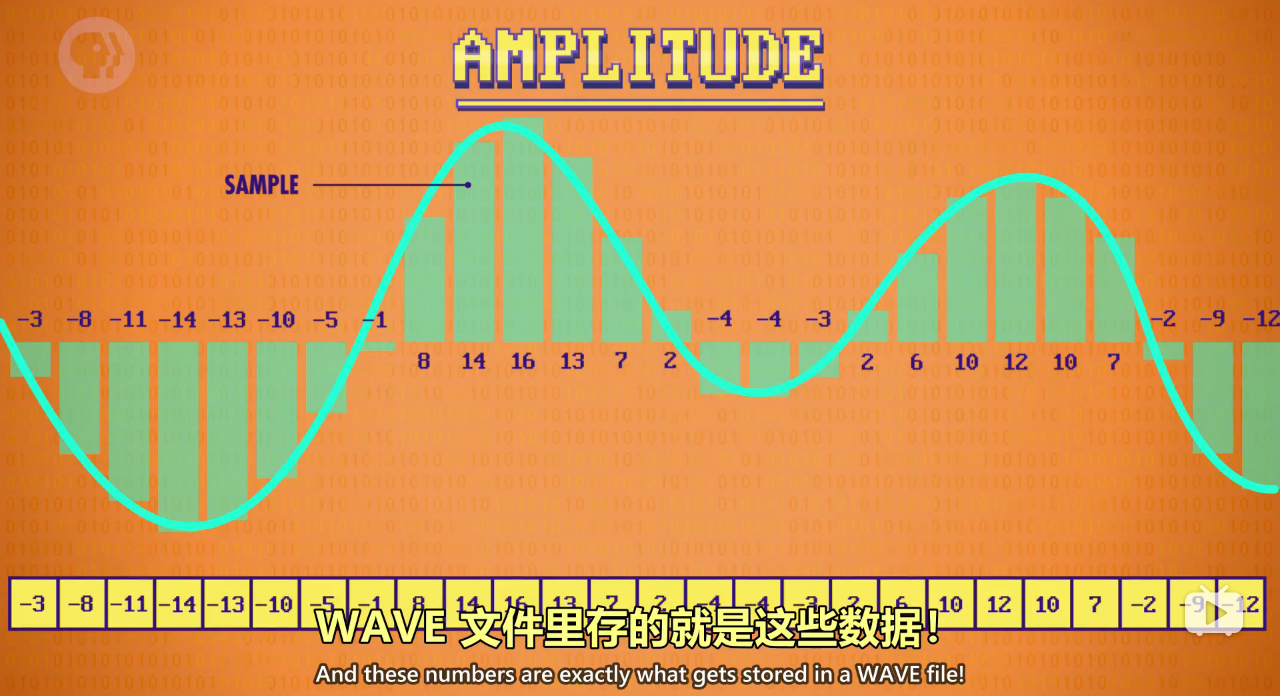
Thousands of amplitudes for every single second of audio!
每秒上千次的振幅!
When it's time to play this file, an audio program needs to actuate the computer's speakers
播放声音文件时,
such that the original waveform is emitted.
扬声器会产生相同的波形
Hello!
你好!
So, now that you're getting the hang of file formats, let's talk about bitmaps or
现在来谈谈 位图(Bitmap),
BMP, which store pictures.
后缀 .bmp, 它存图片
On a computer, Pictures are made up of little tiny square elements called pixels.
计算机上,图片由很多个叫"像素"的方块组成
Each pixel is a combination of three colors: red, green and blue.
每个像素由三种颜色组成:红,绿,蓝
These are called additive primary colors, and they can be mixed together to create any
叫"加色三原色",
other color on our electronic displays.
混在一起可以创造其它颜色
Now, just like WAV files, BMPs start with metadata,
就像 WAV 文件一样,BMP 文件开头也是元数据,
including key values like image width, image height, and color depth.
有图片宽度,图片高度,颜色深度
As an example, let's say the metadata specified an image 4 pixels wide, by 4 pixels tall,
举例,假设元数据说图是 4像素宽 x 4像素高
with a 24-bit color depth that's 8-bits for red, 8-bits for green, and 8-bits for blue.
颜色深度 24 位, 8 位红色,8 位绿色,8 位蓝色
As a reminder, 8 bits is the same as one byte.
提醒一下,8位 (bit) 和 1字节(byte)是一回事
The smallest number a byte can store is 0, and the largest is 255.
一个字节能表示的最小数是 0,最大 255
Our image data is going to look something like this:
图像数据看起来会类似这样:
Let's look at the color of our first pixel.
来看看第一个像素的颜色
It has 255 for its red value, 255 for green and 255 for blue.
红色是255,绿色是255,蓝色也是255
This equates to full intensity red, full intensity green and full intensity blue.
这等同于全强度红色,全强度绿色和全强度蓝色
These colors blend together on your computer monitor to become white.
混合在一起变成白色
So our first pixel is white!
所以第一个像素是白色!
The next pixel has a Red-Green-Blue, or RGB value of 255, 255, 0.
下一个像素的红绿蓝值,或 RGB 值,255,255,0
That's the color yellow!
是黄色!
The pixel after that has a RGB value of 0,0,0 that's zero intensity everything, which is black.
下一个像素是 0,0,0 ,黑色
And the next one is yellow.
下一个是黄色
Because the metadata specified this was a 4 by 4 image, we know that we've reached
因为元数据说图片是 4x4,
the end of our first row of pixels.
我们知道现在到了第一行结尾
So, we need to drop down a row.
所以换一行
The next RGB value is 255,255,0 yellow again.
下一个 RGB 值是 255,255,0,又是黄色
Okay, let's go ahead and read all the pixels in our 4x4 image tada!
好,我们读完剩下的像素
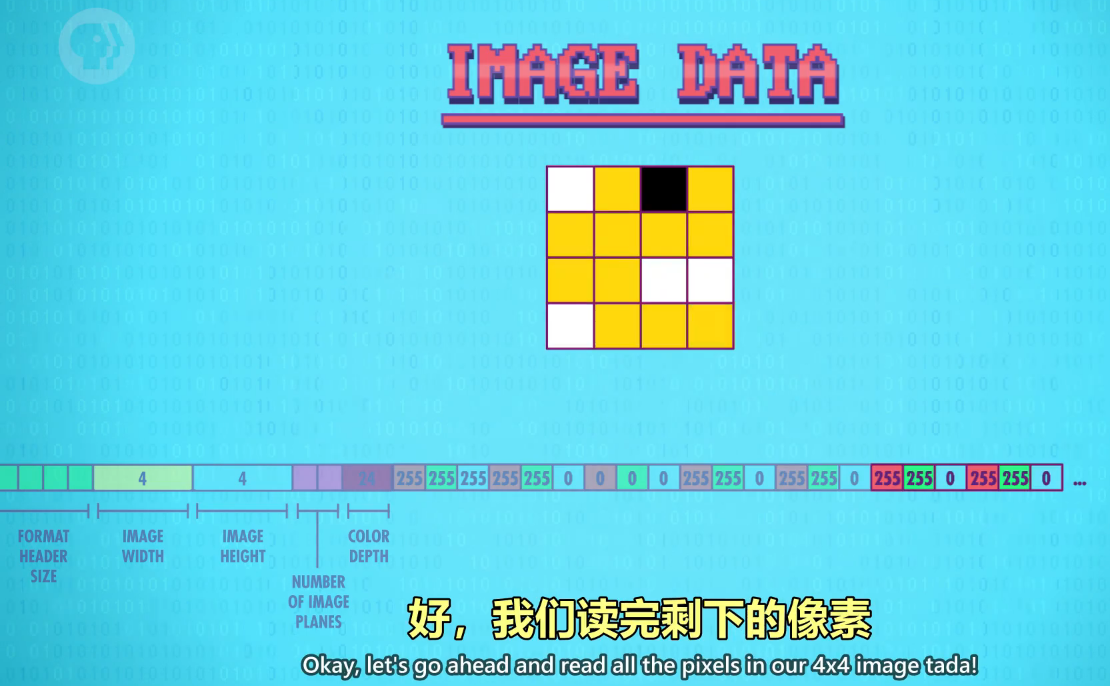
A very low resolution pac-man!
一个低分辨率的吃豆人
Obviously this is a simple example of a small image,
刚才显然只是一个简单例子,
but we could just as easily store this image in a BMP.
但这张图片也可以用 BMP 存
I want to emphasize again that it doesn't matter if it's a text file, WAV,
我想再次强调,不管是文本文件,WAV,BMP
BMP, or fancier formats we don't have time to discuss,
或是我们没时间讨论的其他格式
Under the hood, they're all the same: long lists of numbers, stored as binary, on a storage device.
文件在底层全是一样的: 一长串二进制
File formats are the key to reading and understanding the data inside.
为了知道文件是什么,文件格式至关重要
Now that you understand files a little better, let's move on to
现在你对文件更了解了,
how computers go about storing them.
我们接下来讨论计算机怎么存文件
Even though the underlying storage medium might be
虽然硬件可能是
a strip of tape, a drum, a disk, or integrated circuits...
磁带,磁鼓,磁盘或集成电路
hardware and software abstractions let us think of storage as a
通过软硬件抽象后,
long line of little buckets that store values.
可以看成一排能存数据的桶
In the early days, when computers only performed one computation
在很早期时,计算机只做一件事,
like calculating artillery range tables. the entire storage operated like one big file.
比如算火炮射程表,整个储存器就像一整个文件
Data started at the beginning of storage, and then filled it up in order as output was
数据从头存到尾,
produced, up to the storage capacity.
直到占满
However, as computational power and storage capacity improved, it became possible, and
但随着计算能力和存储容量的提高,
useful, to store more than one file at a time.
存多个文件变得非常有用
The simplest option is to store files back-to-back.
最简单的方法 是把文件连续存储
This can work... but how does the computer know where files begin and end?
这样能用,但怎么知道文件开头和结尾在哪里?
Storage devices have no notion of files C they're just a mechanism for storing lots of bits.
储存器没有文件的概念,只是存储大量位
So, for this to work, we need to have a special file that records where other ones are located.
所以为了存多个文件,需要一个特殊文件,记录其他文件的位置
This goes by many names, but a good general term is Directory File.
这个特殊文件有很多名字,这里泛称 "目录文件"
Most often, it's kept right at the front of storage, so we always know where to access it.
这个文件经常存在最开头,方便找
Location zero!
位置 0!
Inside the Directory File are the names of all the other files in storage.
目录文件里,存所有其他文件的名字
In our example, they each have a name, followed by a period
格式是文件名 + 一个句号 +
and end with what's called a File Extension, like "BMP" or "WAV".
扩展名,比如 BMP 或 WAV
Those further assist programs in identifying file types.
扩展名帮助得知文件类型
The Directory File also stores metadata about these files, like when they were created and
目录文件还存文件的元数据,比如创建时间
last modified, who the owner is, and if it can be read, written or both.
最后修改时间,文件所有者是谁,是否能读/写 或读写都行
But most importantly, the directory file contains where these files
最重要的是,目录文件有
begin in storage, and how long they are.
文件起始位置和长度
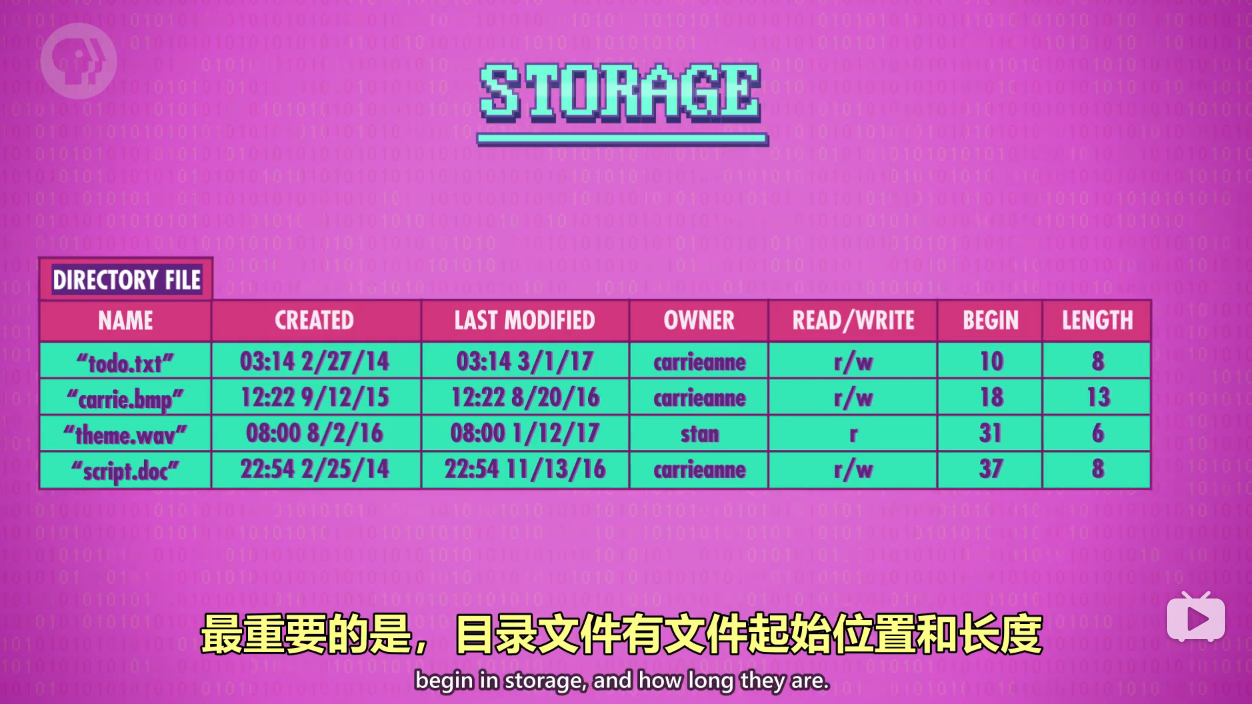
If we want to add a file, remove a file, change a filename, or similar,
如果要添加文件,删除文件,更改文件名等
we have to update the information in the Directory File.
必须更新目录文件
It's like the Table of Contents in a book, if you make a chapter shorter, or move it
就像书的目录,如果缩短或移动了一个章节,
somewhere else, you have to update the table of contents, otherwise the page numbers won't match!
要更新目录,不然页码对不上
The Directory File, and the maintenance of it, is an example of a very basic File System,
目录文件,以及对目录文件的管理,是一个非常简单的文件系统例子
the part of an Operating System that manages and keep track of stored files.
文件系统专门负责管理文件
This particular example is a called a Flat File System, because they're all stored at one level.
刚刚的例子叫"平面文件系统" ,因为文件都在同一个层次
It's flat!
平的!
Of course, packing files together, back-to-back, is a bit of a problem,
当然,把文件前后排在一起 有个问题
because if we want to add some data to let's say "todo.txt",
如果给 todo.txt 加一点数据,
there's no room to do it without overwriting part of "carrie.bmp".
会覆盖掉后面 carrie.bmp 的一部分
So modern File Systems do two things.
所以现代文件系统会做两件事
First, they store files in blocks.
1 把空间划分成一块块,
This leaves a little extra space for changes, called slack space.
导致有一些 "预留空间" 可以方便改动
It also means that all file data is aligned to a common size, which simplifies management.
同时也方便管理
In a scheme like this, our Directory File needs to keep track of
用这样的方案,
what block each one is stored in.
目录文件要记录文件在哪些块里
The second thing File Systems do, is allow files to be broken up into chunks
2 拆分文件,
and stored across many blocks.
存在多个块里
So let's say we open "todo.txt", and we add a few more items then the file becomes
假设打开 todo.txt 加了些内容,
too big to be saved in its one block.
文件太大存不进一块里
We don't want to overwrite the neighboring one, so instead, the File System allocates
我们不想覆盖掉隔壁的块,所以文件系统会分配,
an unused block, which can accommodate extra data.
一个没使用的块,容纳额外的数据
With a File System scheme like this, the Directory File needs to store
目录文件会记录不止一个块,
not just one block per file, but rather a list of blocks per file.
而是多个块
In this way, we can have files of variable sizes that can be easily
只要分配块,
expanded and shrunk, simply by allocating and deallocating blocks.
文件可以轻松增大缩小
If you watched our episode on Operating Systems, this should sound a lot like Virtual Memory.
如果你看了第18集 操作系统,这听起来很像"虚拟内存"
Conceptually it's very similar!
概念上讲的确很像!
Now let's say we want to delete "carrie.bmp".
假设想删掉 carrie.bmp,
To do that, we can simply remove the entry from the Directory File.
只需要在目录文件删掉那条记录
This, in turn, causes one block to become free.
让一块空间变成了可用
Note that we didn't actually erase the file's data in storage, we just deleted the record of it.
注意这里没有擦除数据,只是把记录删了

At some point, that block will be overwritten with new data, but until then, it just sits there.
之后某个时候,那些块会被新数据覆盖,但在此之前,数据还在原处
This is one way that computer forensic teams can "recover" data from computers even
所以计算机取证团队可以"恢复"数据
though people think it has been deleted. Crafty!
虽然别人以为数据已经"删了", 狡猾!
Ok, let's say we add even more items to our todo list, which causes the File System
假设往 todo.txt 加了更多数据,
to allocate yet another block to the file, in this case,
所以操作系统分配了一个新块,
recycling the block freed from carrie.bmp.
用了刚刚 carrie.bmp 的块
Now our "todo.txt" is stored across 3 blocks, spaced apart, and also out of order.
现在 todo.txt 在 3 个块里,隔开了,顺序也是乱的
Files getting broken up across storage like this is called fragmentation.
这叫碎片
It's the inevitable byproduct of files being created, deleted and modified.
碎片是增/删/改文件导致的,不可避免
For many storage technologies, this is bad news.
对很多存储技术来说,碎片是坏事
On magnetic tape, reading todo.txt into memory would require
如果 todo.txt 存在磁带上,读取文件要
seeking to block 1, then fast forwarding to block 5, and then rewinding to block 3
先读块1, 然后快进到块5,然后往回转到块2
that's a lot of back and forth!
来回转个半天
In real world File Systems, large files might be stored across hundreds of blocks,
现实世界中,大文件可能存在数百个块里
and you don't want to have to wait five minutes for your files to open.
你可不想等五分钟才打开文件
The answer is defragmentation!
答案是碎片整理!
That might sound like technobabble, but the process is really simple,
这个词听起来好像很复杂,但实际过程很简单
and once upon a time it was really fun to watch!
以前看计算机做碎片整理 真的很有趣!
The computer copies around data so that files have blocks located together
计算机会把数据来回移动,
in storage and in the right order.
排列成正确的顺序
After we've defragged, we can read our todo file,
整理后 todo.txt 在 1 2 3,
now located in blocks 1 through 3, in a single, quick read pass.
方便读取.
So far, we've only been talking about Flat File Systems,
目前只说了平面文件系统,
where they're all stored in one directory.
文件都在同一个目录里.
This worked ok when computers only had a little bit of storage,
如果存储空间不多,这可能就够用了,
and you might only have a dozen or so files.
因为只有十几个文件
But as storage capacity exploded, like we discussed last episode,
但上集说过,容量爆炸式增长,
so did the number of files on computers.
文件数量也飞速增长
Very quickly, it became impractical to store all files together at one level.
很快,所有文件都存在同一层变得不切实际
Just like documents in the real world, it's handy to store related files together in folders.
就像现实世界,相关文件放在同一个文件夹会方便很多
Then we can put connected folders into folders, and so on.
然后文件夹套文件夹.
This is a Hierarchical File System, and its what your computer uses.
这叫"分层文件系统",你的计算机现在就在用这个.
There are a variety of ways to implement this, but let's stick with the File System example
实现方法有很多种,
we've been using to convey the main idea.
我们用之前的例子来讲重点好了
The biggest change is that our Directory File needs to be able to point not just to files,
最大的变化是 目录文件不仅要指向文件,
but also other directories.
还要指向目录
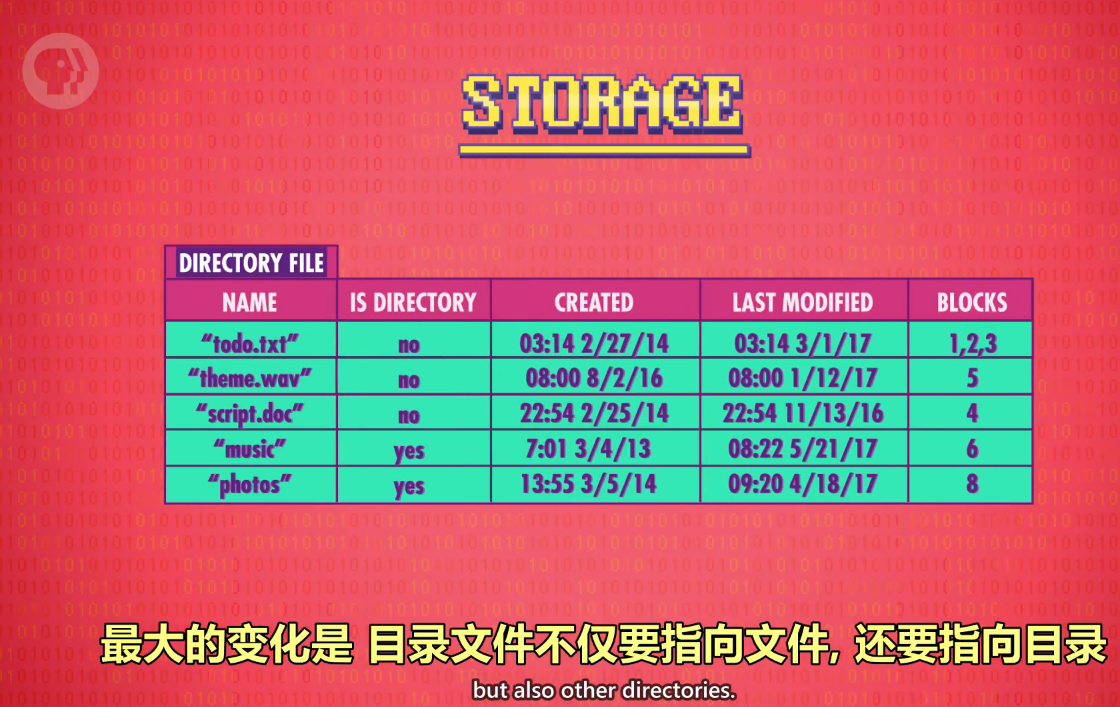
To keep track of what's a file and what's a directory, we need some extra metadata.
我们需要额外元数据 来区分开文件和目录,
This Directory File is the top-most one, known as the Root Directory.
这个目录文件在最顶层,因此叫根目录
All other files and folders lie beneath this directory along various file paths.
所有其他文件和文件夹,都在根目录下
We can see inside of our "Root" Directory File that we have 3 files
图中可以看到根目录文件有3个文件,
and 2 subdirectories: music and photos.
2个子文件夹:"音乐"和"照片"
If we want to see what's stored in our music directory, we have to go to that block and
如果想知道"音乐"文件夹里有什么,
read the Directory File located there; the format is the same as our root directory.
必须去那边读取目录文件(格式和根目录文件一样)
There's a lot of great songs in there!
有很多好歌啊!
In addition to being able to create hierarchies of unlimited depth,
除了能做无限深度的文件夹,
this method also allows us to easily move around files.
这个方法也让我们可以轻松移动文件
So, if we wanted to move "theme.wav" from our root directory to the music directory,
如果想把 theme.wav 从根目录移到音乐目录
we don't have to re-arrange any blocks of data.
不用移动任何数据块
We can simply modify the two Directory Files, removing an entry from one and adding it to another.
只需要改两个目录文件,一个文件里删一条记录,另一个文件里加一条记录
Importantly, the theme.wav file stays in block 5.
theme.wav 依然在块5
So that's a quick overview of the key principles of File Systems.
文件系统的几个重要概念 现在介绍完了.
They provide yet another way to move up a new level of abstraction.
它提供了一层新抽象!
File systems allow us to hide the raw bits stored on magnetic tape, spinning disks and
文件系统使我们不必关心,文件在磁带或磁盘的具体位置
the like, and they let us think of data as neatly organized and easily accessible files.
整理和访问文件更加方便
We even started talking about users, not programmers, manipulating data,
我们像普通用户一样直观操纵数据,
like opening files and organizing them,
比如打开和整理文件
foreshadowing where the series will be going in a few episodes.
接下来几集也会从用户角度看问题
I'll see you next week.
下周见
This episode is brought to you by Curiosity Stream.
本集由 Curiosity Stream 赞助播出